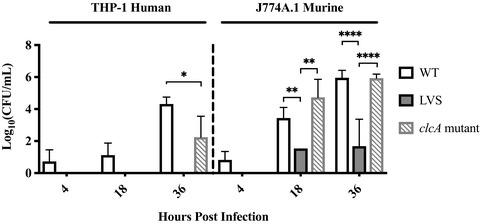当前位置:
X-MOL 学术
›
Microbiologyopen
›
论文详情
Our official English website, www.x-mol.net, welcomes your
feedback! (Note: you will need to create a separate account there.)
A study of innate immune kinetics reveals a role for a chloride transporter in a virulent Francisella tularensis type B strain
MicrobiologyOpen ( IF 3.9 ) Pub Date : 2021-03-24 , DOI: 10.1002/mbo3.1170 Lisa M Matz 1, 2, 3 , Joseph F Petrosino 1, 2, 3
MicrobiologyOpen ( IF 3.9 ) Pub Date : 2021-03-24 , DOI: 10.1002/mbo3.1170 Lisa M Matz 1, 2, 3 , Joseph F Petrosino 1, 2, 3
Affiliation

|
Tularemia is a zoonotic disease of global proportions. Francisella tularensis subspecies tularensis (type A) and holarctica (type B) cause disease in healthy humans, with type A infections resulting in higher mortality. Repeated passage of a type B strain in the mid‐20th century generated the Live Vaccine Strain (LVS). LVS remains unlicensed, does not protect against high inhalational doses of type A, and its exact mechanisms of attenuation are poorly understood. Recent data suggest that live attenuated vaccines derived from type B may cross‐protect against type A. However, there is a dearth of knowledge regarding virulent type B pathogenesis and its capacity to stimulate the host's innate immune response. We therefore sought to increase our understanding of virulent type B in vitro characteristics using strain OR96‐0246 as a model. Adding to our knowledge of innate immune kinetics in macrophages following infection with virulent type B, we observed robust replication of strain OR96‐0246 in murine and human macrophages, reduced expression of pro‐inflammatory cytokine genes from “wild type” type B‐infected macrophages compared to LVS, and delayed macrophage cell death suggesting that virulent type B may suppress macrophage activation. One disruption in LVS is in the gene encoding the chloride transporter ClcA. We investigated the role of ClcA in macrophage infection and observed a replication delay in a clcA mutant. Here, we propose its role in acid tolerance. A greater understanding of LVS attenuation may reveal new mechanisms of pathogenesis and inform strategies toward the development of an improved vaccine against tularemia.
中文翻译:

先天免疫动力学研究揭示了氯离子转运蛋白在 B 型土拉弗朗西斯菌强毒株中的作用
兔热病是一种全球性的人畜共患疾病。土拉弗朗西斯菌亚种tularensis (A 型)和holarctica (B 型)会在健康人类中引起疾病,A 型感染会导致更高的死亡率。 20 世纪中叶 B 型菌株的重复传代产生了活疫苗菌株 (LVS)。 LVS 仍未获得许可,不能防止高吸入剂量的 A 型药物,而且其确切的减毒机制尚不清楚。最近的数据表明,B 型减毒活疫苗可能对 A 型具有交叉保护作用。然而,人们对 B 型强毒发病机制及其刺激宿主先天免疫反应的能力知之甚少。因此,我们试图使用菌株 OR96-0246 作为模型来加深对 B 型毒力体外特征的了解。增加我们对 B 型毒力感染后巨噬细胞先天免疫动力学的了解,我们观察到菌株 OR96-0246 在小鼠和人类巨噬细胞中的强劲复制,“野生型”B 型感染巨噬细胞中促炎细胞因子基因的表达减少与 LVS 相比,巨噬细胞死亡延迟表明 B 型毒力可能抑制巨噬细胞活化。 LVS 的一项破坏是编码氯转运蛋白 ClcA 的基因。我们研究了 ClcA 在巨噬细胞感染中的作用,并观察到clcA突变体的复制延迟。在这里,我们提出了它在耐酸方面的作用。对 LVS 减毒的更深入了解可能会揭示新的发病机制,并为开发改进的兔热病疫苗提供策略。
更新日期:2021-03-24
中文翻译:

先天免疫动力学研究揭示了氯离子转运蛋白在 B 型土拉弗朗西斯菌强毒株中的作用
兔热病是一种全球性的人畜共患疾病。土拉弗朗西斯菌亚种tularensis (A 型)和holarctica (B 型)会在健康人类中引起疾病,A 型感染会导致更高的死亡率。 20 世纪中叶 B 型菌株的重复传代产生了活疫苗菌株 (LVS)。 LVS 仍未获得许可,不能防止高吸入剂量的 A 型药物,而且其确切的减毒机制尚不清楚。最近的数据表明,B 型减毒活疫苗可能对 A 型具有交叉保护作用。然而,人们对 B 型强毒发病机制及其刺激宿主先天免疫反应的能力知之甚少。因此,我们试图使用菌株 OR96-0246 作为模型来加深对 B 型毒力体外特征的了解。增加我们对 B 型毒力感染后巨噬细胞先天免疫动力学的了解,我们观察到菌株 OR96-0246 在小鼠和人类巨噬细胞中的强劲复制,“野生型”B 型感染巨噬细胞中促炎细胞因子基因的表达减少与 LVS 相比,巨噬细胞死亡延迟表明 B 型毒力可能抑制巨噬细胞活化。 LVS 的一项破坏是编码氯转运蛋白 ClcA 的基因。我们研究了 ClcA 在巨噬细胞感染中的作用,并观察到clcA突变体的复制延迟。在这里,我们提出了它在耐酸方面的作用。对 LVS 减毒的更深入了解可能会揭示新的发病机制,并为开发改进的兔热病疫苗提供策略。











































 京公网安备 11010802027423号
京公网安备 11010802027423号